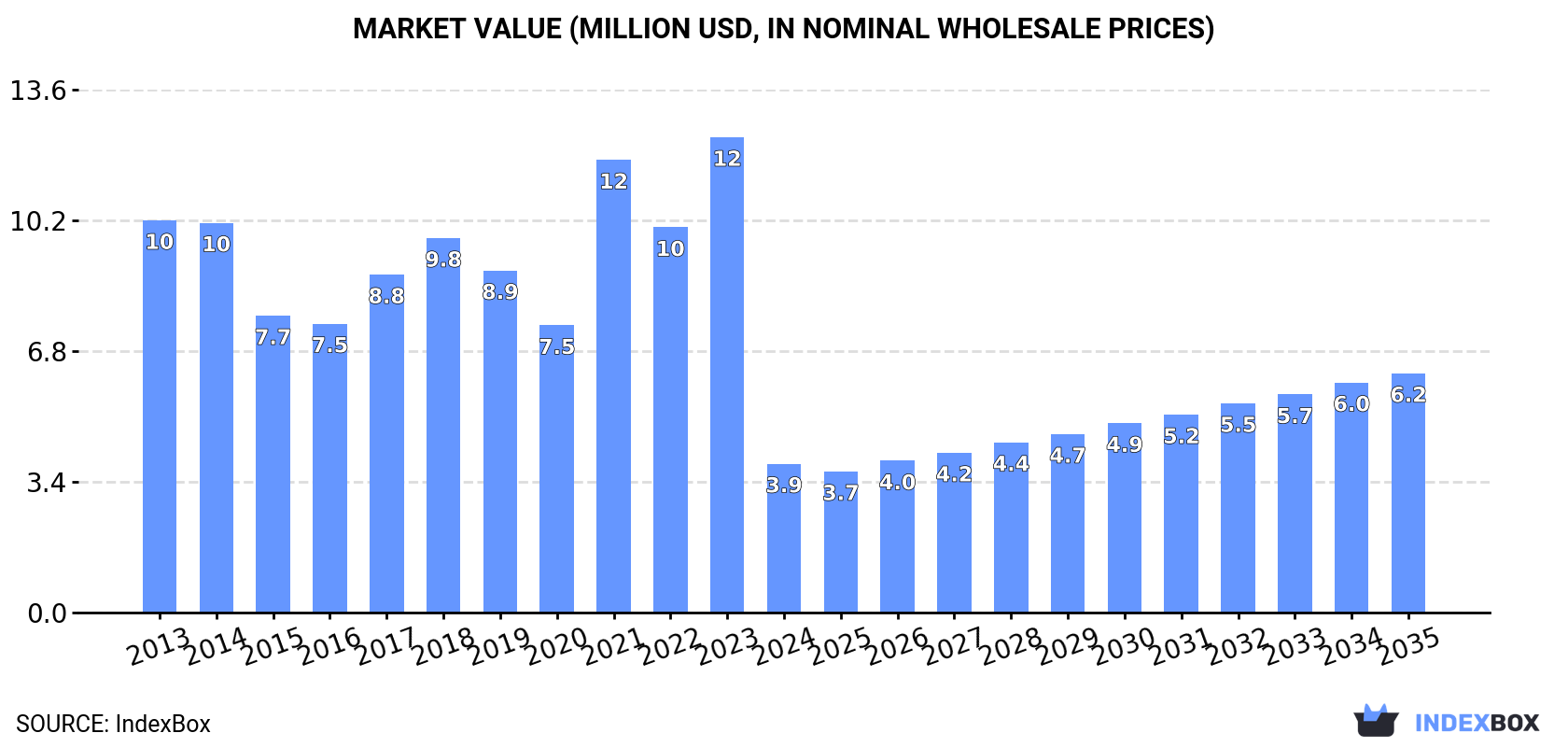Jun 22, 2025
IndexBox has just published a new report: Japan – Hay-Making Machinery – Market Analysis, Forecast, Size, Trends And Insights.
The hay-making machinery market in Japan is set to experience an upward consumption trend in the coming years, with a forecasted CAGR of +1.2% in volume and +4.4% in value from 2024 to 2035. By the end of 2035, market volume is expected to reach 282 units, with a market value of $6.2M in nominal prices.
Market Forecast
Driven by rising demand for hay-making machinery in Japan, the market is expected to start an upward consumption trend over the next decade. The performance of the market is forecast to increase slightly, with an anticipated CAGR of +1.2% for the period from 2024 to 2035, which is projected to bring the market volume to 282 units by the end of 2035.
In value terms, the market is forecast to increase with an anticipated CAGR of +4.4% for the period from 2024 to 2035, which is projected to bring the market value to $6.2M (in nominal wholesale prices) by the end of 2035.
 ConsumptionJapan’s Consumption of Hay-Making Machinery
ConsumptionJapan’s Consumption of Hay-Making Machinery
In 2024, approx. 247 units of hay-making machinery were consumed in Japan; falling by -68.2% compared with the previous year’s figure. Overall, consumption saw a deep contraction. As a result, consumption attained the peak volume of 789 units. From 2022 to 2024, the growth of the consumption failed to regain momentum.
The size of the hay-making machinery market in Japan fell rapidly to $3.9M in 2024, reducing by -68.7% against the previous year. This figure reflects the total revenues of producers and importers (excluding logistics costs, retail marketing costs, and retailers’ margins, which will be included in the final consumer price). In general, consumption showed a abrupt downturn. Hay-making machinery consumption peaked at $12M in 2023, and then contracted dramatically in the following year.
ImportsJapan’s Imports of Hay-Making Machinery
In 2024, approx. 251 units of hay-making machinery were imported into Japan; which is down by -67.9% against the previous year’s figure. Over the period under review, imports recorded a abrupt setback. The most prominent rate of growth was recorded in 2021 when imports increased by 48%. As a result, imports attained the peak of 794 units. From 2022 to 2024, the growth of imports remained at a somewhat lower figure.
In value terms, hay-making machinery imports declined sharply to $4M in 2024. In general, imports recorded a abrupt decline. The pace of growth appeared the most rapid in 2021 with an increase of 58%. Imports peaked at $13M in 2023, and then declined markedly in the following year.
Imports By Country
In 2023, France (465 units) constituted the largest supplier of hay-making machinery to Japan, with a 59% share of total imports. Moreover, hay-making machinery imports from France exceeded the figures recorded by the second-largest supplier, Germany (172 units), threefold. The third position in this ranking was held by Austria (44 units), with a 5.6% share.
From 2013 to 2023, the average annual growth rate of volume from France stood at +1.4%. The remaining supplying countries recorded the following average annual rates of imports growth: Germany (+4.2% per year) and Austria (+47.2% per year).
In value terms, France ($7.5M) constituted the largest supplier of hay-making machinery to Japan, comprising 59% of total imports. The second position in the ranking was taken by Germany ($2.9M), with a 23% share of total imports. It was followed by Austria, with a 4.6% share.
From 2013 to 2023, the average annual rate of growth in terms of value from France totaled +2.3%. The remaining supplying countries recorded the following average annual rates of imports growth: Germany (+4.4% per year) and Austria (+47.7% per year).
Import Prices By Country
In 2023, the average hay-making machinery import price amounted to $16 thousand per unit, with an increase of 16% against the previous year. Over the period from 2013 to 2023, it increased at an average annual rate of +1.2%. As a result, import price attained the peak level and is likely to continue growth in the immediate term.
There were significant differences in the average prices amongst the major supplying countries. In 2023, amid the top importers, the country with the highest price was Italy ($22 thousand per unit), while the price for Austria ($13 thousand per unit) was amongst the lowest.
From 2013 to 2023, the most notable rate of growth in terms of prices was attained by Italy (+7.4%), while the prices for the other major suppliers experienced more modest paces of growth.
ExportsJapan’s Exports of Hay-Making Machinery
Hay-making machinery exports from Japan declined remarkably to 4 units in 2024, dropping by -33.3% on 2023. In general, exports, however, enjoyed a buoyant increase. The pace of growth was the most pronounced in 2019 when exports increased by 1,500% against the previous year. As a result, the exports reached the peak of 16 units. From 2020 to 2024, the growth of the exports remained at a lower figure.
In value terms, hay-making machinery exports plummeted to $72K in 2024. Overall, exports, however, posted buoyant growth. The pace of growth was the most pronounced in 2019 with an increase of 7,764%. As a result, the exports attained the peak of $446K. From 2020 to 2024, the growth of the exports failed to regain momentum.
Exports By Country
The United States (4 units) was the main destination for hay-making machinery exports from Japan, accounting for a 67% share of total exports. Moreover, hay-making machinery exports to the United States exceeded the volume sent to the second major destination, Russia (1 units), fourfold. New Zealand (1 units) ranked third in terms of total exports with a 17% share.
From 2013 to 2023, the average annual growth rate of volume to the United States amounted to +18.9%. Exports to the other major destinations recorded the following average annual rates of exports growth: Russia (-6.7% per year) and New Zealand (0.0% per year).
In value terms, the United States ($63K) emerged as the key foreign market for hay-making machinery exports from Japan, comprising 65% of total exports. The second position in the ranking was held by New Zealand ($15K), with a 15% share of total exports. It was followed by South Korea, with a 9.6% share.
From 2013 to 2023, the average annual growth rate of value to the United States stood at +30.3%. Exports to the other major destinations recorded the following average annual rates of exports growth: New Zealand (+23.6% per year) and South Korea (-55.1% per year).
Export Prices By Country
In 2023, the average hay-making machinery export price amounted to $16 thousand per unit, falling by -20.7% against the previous year. In general, the export price, however, posted a modest increase. The pace of growth appeared the most rapid in 2015 an increase of 748%. Over the period under review, the average export prices reached the peak figure at $28 thousand per unit in 2019; however, from 2020 to 2023, the export prices failed to regain momentum.
Prices varied noticeably by country of destination: amid the top suppliers, the country with the highest price was the United States ($16 thousand per unit), while the average price for exports to Russia ($3.8 thousand per unit) was amongst the lowest.
From 2013 to 2023, the most notable rate of growth in terms of prices was recorded for supplies to Taiwan (Chinese) (+27.3%), while the prices for the other major destinations experienced more modest paces of growth.
Source: IndexBox Market Intelligence Platform
